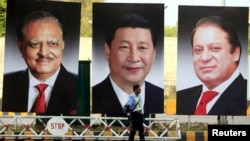Leaders in Islamabad and Beijing have often dubbed the China-Pakistan Economic Corridor (CPEC) as a “game changer” and the answer to all of Pakistan’s economic woes.
But a new study has warned that major Chinese investments in Pakistani infrastructure, energy, and industry could stir unrest because of the effects on locals along the corridor’s routes as most of its profits are expected to flow to outsiders.
“It [CPEC] will deepen friction between the federal center and periphery, roil provinces already long neglected, widen social divides, and potentially create new sources of conflict,” the study by the International Crisis Group (ICG) warned.
The June 29 report by the Brussels-based think tank noted that if Islamabad fails to thoroughly debate the investments in parliament and provincial legislatures and consult with locals, they are unlikely to revive Pakistan’s ailing economy.
“Many of these problems stem from opaque policy formulation and the failure to heed regional and local concerns,” the paper noted. “CPEC’s Long-Term Plan (2017-2030) was formulated by the center with little input from local leaders, business or civil society actors.”
The ICG says prominent Pakistani businessmen and some senior officials are concerned over the likely economic impact of CPEC because it subordinates Islamabad’s interests to those of Beijing. “[They are] concerned about the failure to protect local economic interests, high guaranteed returns on equity to Chinese investors, and unaffordable national debt,” the report noted.
CPEC is a project of Beijing’s ambitious One Belt, One Road (OBOR) or Belt and Road initiative, which aims to transform the economic and political landscape across Asia through investments in infrastructure, connectivity, trade, and energy.
Launched in April 2015, CPEC seeks to make around $60 billion in loans, investments, and grants in building transport infrastructure, energy projects, industrial parks, and agricultural modernization.
Spanning a 2,700-kilometer route, CPEC aims to connect the Arabian Sea port of Gwadar in southwestern Pakistan to the Kashghar prefecture in China’s northwestern Xinjiang region.
The ICG says the projects risk inflaming tensions between Islamabad, the eastern Punjab Province, and the three minority provinces of Balochistan, Khyber Pakhtunkhwa, and Sindh.
“Less-developed federal units such as Balochistan and [southern] Sindh contend that the corridor’s route, infrastructure, and industrial projects will mostly benefit Punjab, already the country’s wealthiest and politically powerful province,” the report said. “Yet, even in Punjab, locals could forcibly resist the state’s acquisition of land for CPEC’s agricultural projects.”
Since 2004, Balochistan has reeled from a simmering separatist insurgency. The influx of Chinese money and interest, according the ICG, is not helping.
“CPEC is exacerbating existing grievances among a population whose perceptions of exploitation and neglect by the center, together with authorities’ suppression of dissent, have long fueled an insurgency,” the report said.
The report details the harsh impact of CPEC on Gwadar, which Beijing is seeking to transform into Shenzhen.
“Instead of developing a sleepy fishing village into a bustling commercial hub as pledged by Islamabad and Beijing, the project is producing a heavily militarized zone,” the report said.
The ICG noted that in Sindh’s rural Tharparkar district, “coal-based CPEC power projects are not only damaging the environment but are also displacing locals from their homes and could destroy livelihoods.”
The report recommends Pakistan’s incoming government, slated to assume office after the July 25 election, should encourage debate on CPEC. It advised Beijing to support such debate, hire local labor, and engage in fair competition.
“Both Islamabad and Beijing need to implement it [CEPC] with considerably more sensitivity and consultation than they have displayed thus far,” it said.







